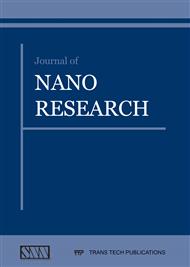[1]
M.J. Gómez, M.M. Bueno, S. Lacorte, A.R. Fernández-Alba, A. Agüera, Pilot survey monitoring pharmaceuticals and related compounds in a sewage treatment plant located on the Mediterranean coast, Chemosphere, 66 (2007) 993-1002.
DOI: 10.1016/j.chemosphere.2006.07.051
Google Scholar
[2]
M.J. Martínez Bueno, A. Agüera, M.J. Gómez, M.D. Hernando, J.F. García-Reyes, A.R. Fernández-Alba, Application of liquid chromatography/quadrupole-linear ion trap mass spectrometry and time-of-flight mass spectrometry to the determination of pharmaceuticals and related contaminants in wastewater, Analytical Chemistry, 79 (2007).
DOI: 10.1021/ac0715672
Google Scholar
[3]
J. Radjenović, M. Petrović, D. Barceló, Advanced mass spectrometric methods applied to the study of fate and removal of pharmaceuticals in wastewater treatment, TrAC Trends in Analytical Chemistry, 26 (2007) 1132-1144.
DOI: 10.1016/j.trac.2007.10.002
Google Scholar
[4]
B. Kasprzyk-Hordern, R.M. Dinsdale, A.J. Guwy, The occurrence of pharmaceuticals, personal care products, endocrine disruptors and illicit drugs in surface water in South Wales, UK, Water Research, 42 (2008) 3498-3518.
DOI: 10.1016/j.watres.2008.04.026
Google Scholar
[5]
B. Hileman, Antiseptic soaps under scrutiny, in AMERICAN CHEMICAL SOC 1155 16TH ST, NW, WASHINGTON, DC 20036 USA, (2005).
Google Scholar
[6]
A. El-Ghenymy, P.L. Cabot, F. Centellas, J.A. Garrido, R.M. Rodríguez, C. Arias, E. Brillas, Mineralization of sulfanilamide by electro-Fenton and solar photoelectro-Fenton in a pre-pilot plant with a Pt/air-diffusion cell, Chemosphere, 91 (2013).
DOI: 10.1016/j.chemosphere.2013.03.005
Google Scholar
[7]
P. Wang, T. Zhou, R. Wang, T. -T. Lim, Carbon-sensitized and nitrogen-doped TiO 2 for photocatalytic degradation of sulfanilamide under visible-light irradiation, Water Research, 45 (2011) 5015-5026.
DOI: 10.1016/j.watres.2011.07.002
Google Scholar
[8]
W. Baran, E. Adamek, A. Sobczak, J. Sochacka, The comparison of photocatalytic activity of Fe-salts, TiO 2 and TiO 2/FeCl 3 during the sulfanilamide degradation process, Catalysis Communications, 10 (2009) 811-814.
DOI: 10.1016/j.catcom.2008.12.026
Google Scholar
[9]
T.E. Doll, F.H. Frimmel, Kinetic study of photocatalytic degradation of carbamazepine, clofibric acid, iomeprol and iopromide assisted by different TiO 2 materials—determination of intermediates and reaction pathways, Water Research, 38 (2004).
DOI: 10.1016/j.watres.2003.11.009
Google Scholar
[10]
M. Abellán, B. Bayarri, J. Giménez, J. Costa, Photocatalytic degradation of sulfamethoxazole in aqueous suspension of TiO 2, Applied Catalysis B: Environmental, 74 (2007) 233-241.
DOI: 10.1016/j.apcatb.2007.02.017
Google Scholar
[11]
A. Chatzitakis, C. Berberidou, I. Paspaltsis, G. Kyriakou, T. Sklaviadis, I. Poulios, Photocatalytic degradation and drug activity reduction of chloramphenicol, Water Research, 42 (2008) 386-394.
DOI: 10.1016/j.watres.2007.07.030
Google Scholar
[12]
S. Kaneco, H. Katsumata, T. Suzuki, K. Ohta, Titanium dioxide mediated photocatalytic degradation of dibutyl phthalate in aqueous solution—kinetics, mineralization and reaction mechanism, Chemical Engineering Journal, 125 (2006) 59-66.
DOI: 10.1016/j.cej.2006.08.004
Google Scholar
[13]
B. Xu, N. -Y. Gao, X. -F. Sun, S. -J. Xia, M. Rui, M. -O. Simonnot, C. Causserand, J. -F. Zhao, Photochemical degradation of diethyl phthalate with UV/H 2 O 2, Journal of hazardous materials, 139 (2007) 132-139.
DOI: 10.1016/j.jhazmat.2006.06.026
Google Scholar
[14]
P. Fernández-Ibáñez, J. Blanco, S. Malato, F. De Las Nieves, Application of the colloidal stability of TiO 2 particles for recovery and reuse in solar photocatalysis, Water Research, 37 (2003) 3180-3188.
DOI: 10.1016/s0043-1354(03)00157-x
Google Scholar
[15]
M. Aliabadi, T. Sagharigar, H. Ghahremani, M. Ebadi, The Influence of pH and Inorganic anion on the Photocatalytic Degradation of 2-Benzyle-4-Cholorophenol in Titanium dioxide Suspension, Fresenius Environmental Bulletin, 22 (2013).
Google Scholar
[16]
C.D. Jaeger, A.J. Bard, Spin trapping and electron spin resonance detection of radical intermediates in the photodecomposition of water at titanium dioxide particulate systems, Journal of Physical Chemistry, 83 (1979) 3146-3152.
DOI: 10.1021/j100487a017
Google Scholar
[17]
D.S. Bhatkhande, V.G. Pangarkar, A.A. Beenackers, Photocatalytic degradation for environmental applications–a review, Journal of Chemical Technology and Biotechnology, 77 (2002) 102-116.
DOI: 10.1002/jctb.532
Google Scholar
[18]
R.R. Giri, H. Ozaki, S. Ota, S. Taniguchi, R. Takanami, Influence of inorganic solids on photocatalytic oxidation of 2, 4-dichlorophenoxyacetic acid with UV and TiO 2 fiber in aqueous solution, Desalination, 255 (2010) 9-14.
DOI: 10.1016/j.desal.2010.01.025
Google Scholar
[19]
Y. Ku, J. -J. Hung, W. -Y. Wang, Decomposition of 2-nitrophenol in aqueous solution by ozone and UV/ozone processes, Water environment research, (2006) 901-908.
DOI: 10.2175/106143005x78672
Google Scholar


